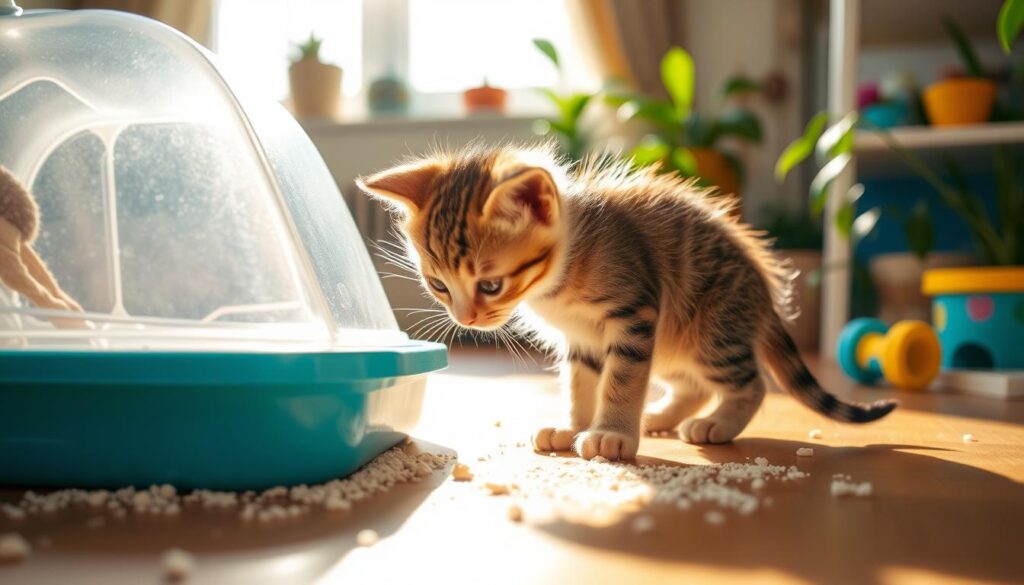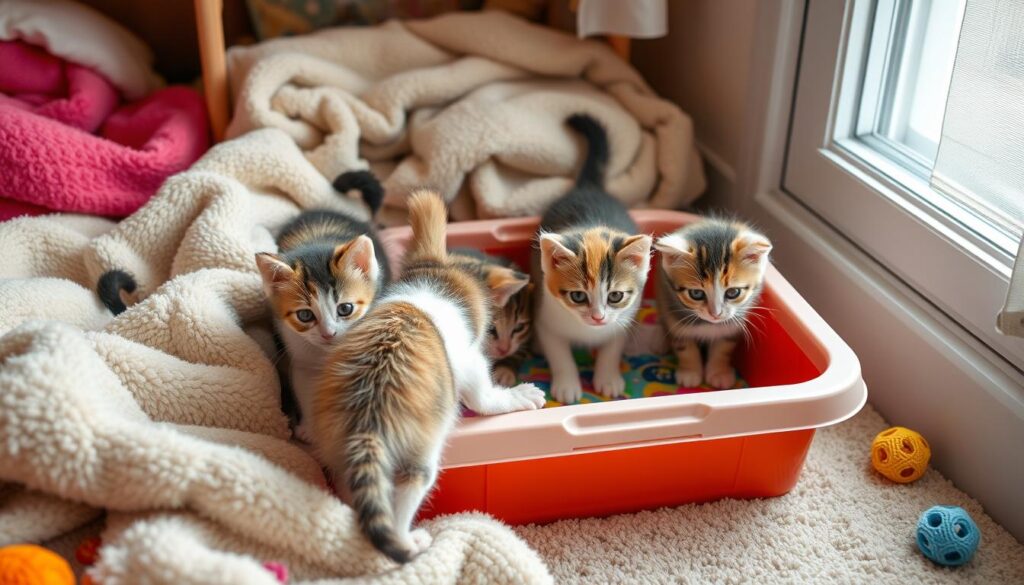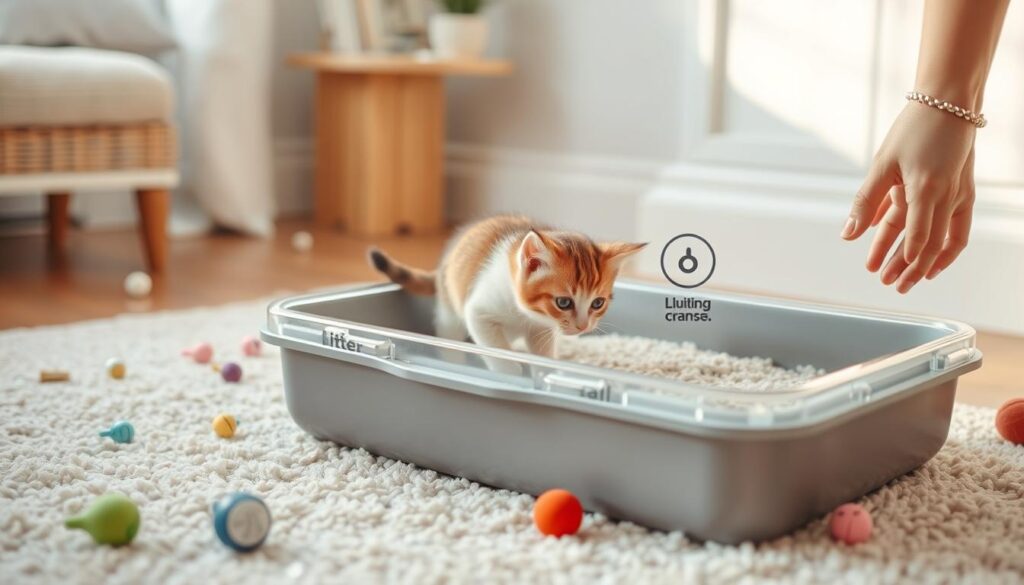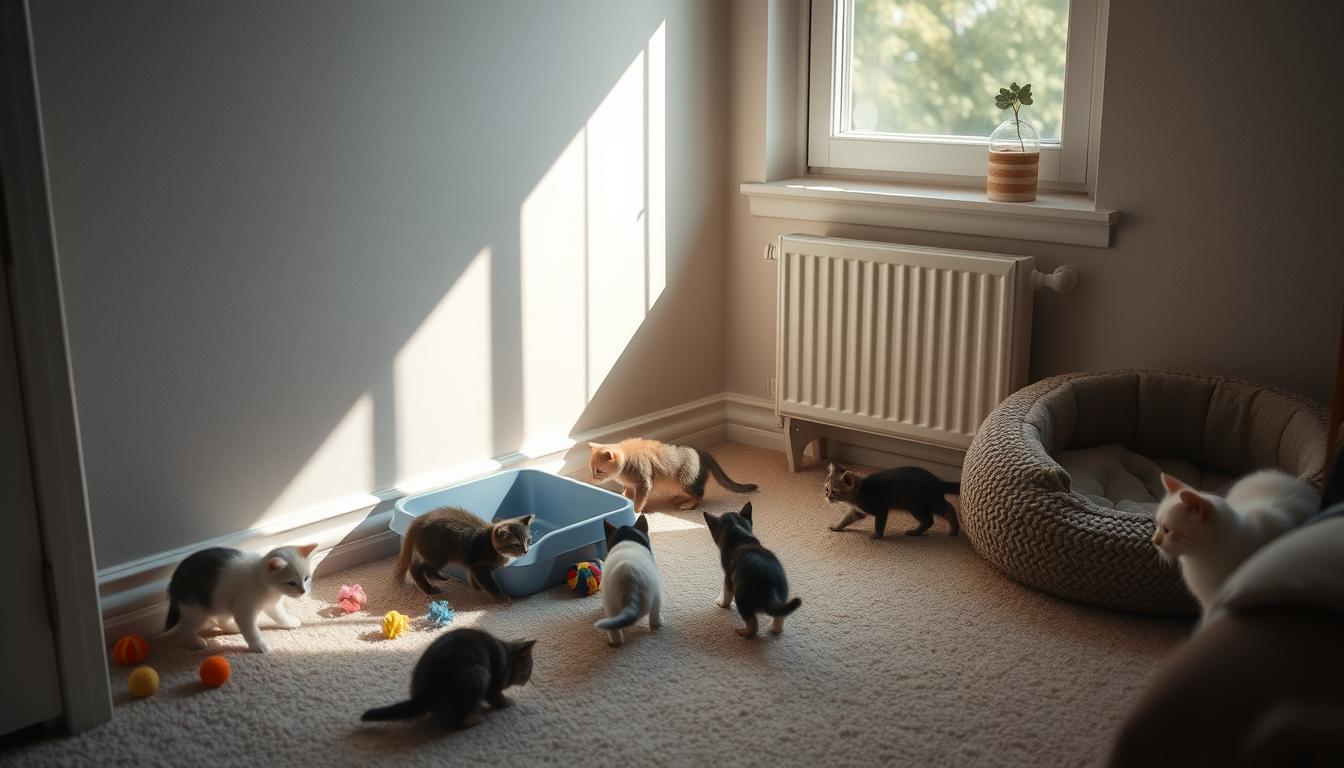Learning to litter train a kitten is key for a happy home. It takes patience, consistency, and positive feedback. We’ll show you how to train your kitten, from picking the right litter box to solving common problems.
Proper litter box training is vital to avoid accidents and teach your kitten good habits. Our guide will help you train your kitten successfully. It’s perfect for both new and experienced cat owners, offering useful tips and insights.
Key Takeaways
- Start litter training your kitten as early as possible
- Choose a litter box that is large enough for your kitten
- Select a quiet and private location for the litter box
- Use positive reinforcement techniques to encourage good behavior
- Be patient and consistent during the training process
- Watch for signs that your kitten needs to use the litter box
- Address common challenges and accidents promptly
Understanding Your Kitten’s Natural Instincts
Kittens are born with a natural urge to use loose places to go to the bathroom. This is because their wild ancestors used to bury their waste to hide from predators. This instinct helps and hinders when training kittens to use a litter box.
Kittens are drawn to loose substrate because it lets them dig and bury their waste easily. This behavior is both instinctual and comforting for them. It helps them feel safe and secure, just like in the wild.
The Role of Scent in Litter Box Behavior
Scent is very important in litter box behavior, especially for kittens. Kittens use scent to mark their territory and talk to other cats. This can help or hinder litter training, depending on how the litter box smells.
Age-Related Bathroom Behaviors
Kittens’ bathroom habits change as they grow. Younger kittens need their litter boxes cleaned more often. Older kittens might be pickier about the litter they use. Knowing these changes helps with effective litter training.
Essential Supplies for Successful Litter Training
To start easy steps to train a kitten to use the litter box, you need the right stuff. Get a litter box big enough for your kitten to move around in. Also, a non-slip mat under the box helps it stay put. Kitten toilet training techniques might take some trying, so have different litters ready.
Some important things to get include:
- Litter boxes with low sides for easy access
- Unscented litter to reduce overwhelming smells
- A scoop and bags for cleaning up after your kitten
- A litter box cleaner to keep the area hygienic
Think about what your kitten likes and needs. Some might like certain litters or box designs. With the right supplies and easy steps to train a kitten to use the litter box, your kitten will do great. This makes kitten toilet training techniques easier.
Every kitten is unique, and what works for one might not for another. Be patient and try different supplies and methods. This way, you’ll find what’s best for your kitten.
Choosing the Perfect Litter Box Location
When training a kitten to use the litter box, where you place it matters a lot. A well-chosen spot can make your kitten use it regularly. This makes the how to litter train a kitten task simpler. The litter box should be in a quiet, private spot where your kitten can get to it easily.
It’s best to put the litter box in a place not many people go. This keeps it away from where your kitten eats and drinks. Good spots might be a laundry room or a bathroom.
Ideal Spots in Your Home
- A quiet corner of a bedroom
- A laundry room or utility closet
- A bathroom, as long as it’s not too close to the shower or bathtub
Places to Avoid
- High-traffic areas, such as the kitchen or living room
- Areas near your kitten’s food and water bowls
- Areas with loud noises, such as near a washing machine or dryer
Choosing the right spot for your kitten’s litter box makes training easier. Keep the litter box clean and easy for your kitten to find. Also, give lots of praise and rewards when it uses the litter box right.
Selecting the Right Type of Cat Litter
Choosing the right cat litter is key for kitten litter box training. It’s important to pick a litter that your kitten likes and finds comfortable. There are many types of cat litter, like clumping, non-clumping, scented, and unscented.
Some kittens might like natural alternatives like pine or recycled paper litter. Others might prefer traditional clay litter. Think about what your kitten likes and needs when picking a litter. Try different litters to see what your kitten prefers. Make the switch slowly to avoid stress.
Here are some things to think about when picking a cat litter:
- Odor control: If you have many cats, look for a litter that controls smells well.
- Comfort: Pick a litter that’s soft on your kitten’s paws and easy to dig in.
- Environmental impact: If you care about the planet, choose a natural or biodegradable litter.
By thinking about these points and picking the right litter, kitten training can be easier and less stressful for both you and your kitten.
Remember, every kitten is different, so it may take some trial and error to find the perfect litter for your kitten.
How to Litter Train a Kitten: The Core Process
Teaching a kitten to use the litter box needs patience, consistency, and positive feedback. It’s important to set a routine. Start by putting your kitten in the litter box after meals and naps. This links these activities to the litter box.
Start a morning routine with your kitten. Feed them and then put them in the litter box. This links the litter box to eliminating. As they get used to it, you can wait longer between feedings and litter box visits.
Morning Routine
It’s also key to take your kitten to the litter box after play and naps. This links these activities to the litter box. A consistent routine helps your kitten develop good habits and reduces accidents.
After-Meal Training
Training after meals is crucial. Take your kitten to the litter box after eating. This links eating to eliminating. It helps your kitten develop a routine and reduces accidents.
Positive Reinforcement Techniques
Use positive reinforcement like praise and rewards. Praise and reward your kitten when they use the litter box right. This makes the litter box a positive place for them.
Follow these tips and keep a consistent routine. This helps your kitten learn to use the litter box and develop good habits. Always be patient and consistent, as it takes time and effort.
Signs Your Kitten Needs to Use the Litter Box
Starting kitten potty training means knowing when your kitten needs to go. Spotting these signs helps you guide them to the litter box. This way, you prevent accidents and teach them good habits. Sniffing is a key sign, as your kitten will sniff the floor or a spot to find the right place to go.
Scratching is another important sign. It often leads to digging and burying waste. If your kitten starts scratching or meowing, it’s time to take them to the litter box. Quick action helps your kitten learn how to litter train a kitten well.
Here are some key signs to watch for:
- Sniffing or circling a specific area
- Scratching or digging
- Meowing or vocalizing
- Squatting or crouching
By noticing these signs and acting fast, you can teach your kitten good litter box habits. Always keep an eye on your kitten, especially when they’re learning. This ensures they use the litter box correctly.

Common Litter Box Training Challenges
Training a kitten to use the litter box can face some hurdles. Knowing how to handle these issues is key. Factors like the litter box’s location, size, and litter type can make a kitten avoid it.
Another issue is when a kitten goes outside the litter box. This might be due to health problems, stress, or feeling anxious. Creating a calm space for your kitten can help with litter box anxiety. Recognizing the signs of anxiety is the first step to making your kitten feel safe.
To tackle these problems, finding the root cause is essential. You might need to move the litter box, change the litter, or add more boxes. By understanding these challenges and using the right techniques, you can help your kitten learn to use the litter box correctly.
Avoiding the Box
- Check the litter box’s location and size to ensure it’s comfortable for the kitten
- Try different types of litter to find one that the kitten prefers
- Provide a calm and quiet environment for the kitten to use the litter box
Inappropriate Elimination
- Consult with a veterinarian to rule out medical issues
- Reduce stress and anxiety by providing a comfortable and secure environment
- Increase the number of litter boxes to prevent competition and accidents
Maintaining a Clean Litter Environment
Keeping the litter box clean is key when training a kitten. A dirty litter box can make your kitten avoid it. This can lead to accidents and slow down training. To litter train a kitten well, clean the litter box regularly.
Every day, you need to remove solid waste and clumps. Also, add more litter when it’s needed. Set aside time each week to deep clean and disinfect the litter box.
Daily Maintenance Tasks
- Scoop out solid waste and clumps daily
- Refill the litter as needed
- Check the litter box for any signs of damage or wear
Weekly Cleaning Schedule
Change the litter completely every 7-10 days, or when it’s dirty. This stops bacteria and bad smells. It keeps your kitten healthy and happy. By doing these simple steps, you make a clean and comfy litter area. This will help your kitten use the litter box often.
Training Multiple Kittens Simultaneously
Training kitten litter box training with multiple kittens can be tough. It’s key to have enough litter boxes. Aim for one box per kitten, plus an extra. This reduces competition and stress, making training easier.
It’s vital to give each kitten its own space for eating, sleeping, and playing. This stops bullying and helps them learn good litter box habits. Spend time with each kitten and reward them for good behavior.
Here are some tips for training multiple kittens at once:
- Provide a quiet and private area for each kitten to use the litter box
- Use a consistent litter type and keep the litter boxes clean
- Supervise kittens during litter box use to prevent bullying or competition
- Reward good behavior with treats and praise
By following these tips and being patient, you can train multiple kittens. Remember, kitten litter box training and how to litter train a kitten need time, effort, and consistency. With the right approach, your kittens will learn good habits and you’ll all be happier.

Health Issues That May Affect Litter Box Training
When teaching a kitten to use the litter box, knowing about health issues is key. Kittens with urinary tract infections or digestive problems might struggle. Litter training tips for kittens stress the need to watch your kitten’s health and adjust training if needed.
Some common health problems that can affect litter box training include:
- Urinary tract infections
- Digestive problems
- Pain or discomfort while urinating or defecating
Physical Health Concerns
Kittens with health issues might show signs like straining to pee or frequent accidents. If you see these signs, it’s important to see a vet. They can help figure out the health problem and how to change the training.
Behavioral Health Issues
Behavioral health issues, like stress or anxiety, can also affect training. Kittens might avoid the litter box or have accidents elsewhere. Litter training tips for kittens suggest creating a calm space, reducing stress, and using positive rewards for good behavior.
Special Considerations for Different Age Groups
When it comes to kitten potty training, age matters a lot. Each age group needs a special way to learn. For very young kittens, start with easy steps like putting them in the litter box after meals and naps.
As kittens get older, they need less watching but still a routine. Older kittens might like praise and rewards for good behavior. Adult cats might need more patience because they’ve learned bad habits.
Some important things to think about for different ages are:
- Very young kittens: Start with short training sessions and gradually increase duration
- Slightly older kittens: Encourage independence and self-cleaning
- Adult cats: Be patient and consistent, and consider seeking professional help if necessary
By adjusting your training to your kitten’s age, you can make potty training a success. Always be patient and consistent. If you hit a roadblock, don’t hesitate to get help from a pro.
Transitioning Between Different Litter Types
Transitioning your kitten to a new litter type is a big part of kitten toilet training. It needs patience and a slow approach to keep your kitten’s habits on track. Changing litter can confuse your kitten and lead to accidents.
To start the transition, mix a bit of the new litter with the old one. This lets your kitten get used to the new smell and feel. Slowly add more of the new litter over days or weeks, based on how your kitten adapts. Watch for any signs of discomfort or dislike.

- Choose a litter that feels and smells similar to the old one to cause less upset.
- Introduce the new litter when your kitten is calm and not stressed.
- Be ready for accidents and have a plan to clean up any messes.
By following these tips and using good kitten toilet training methods, you can help your kitten get used to the new litter. Remember, being patient and consistent is crucial. With time and effort, your kitten will learn to use the new litter well.
Advanced Tips for Stubborn Cases
Dealing with stubborn kittens requires effective ways to litter train a kitten. You might need to change the environment to help them use the litter box. This could mean adding more litter boxes, trying different litters, or moving the litter box to a better spot.
Behavioral interventions can also help. Positive reinforcement, like treats or praise, can encourage the kitten to use the litter box. Remember, patience and consistency are key when learning how to litter train a kitten.
Some kittens might need special help, like a litter box with low sides or a ramp. In these cases, working with a vet or animal behaviorist is crucial. They can help create a training plan tailored to your kitten’s needs. With these advanced tips, even the most stubborn kittens can learn to use the litter box.
Here are some more tips to consider:
- Clean the litter box more often to make it more appealing to the kitten
- Place multiple litter boxes in different spots to give the kitten choices
- Use a pheromone spray to draw the kitten to the litter box
By following these tips and staying patient and consistent, you can teach your kitten to use the litter box. Always reward good behavior and avoid punishing them for accidents. This helps prevent negative feelings towards the litter box.
Celebrating Your Successfully Trained Kitten
Congratulations on successfully litter training your kitten! This achievement starts a beautiful journey together. You’ve made your home cleaner and strengthened your bond with your pet.
Now, you can enjoy a clean, stress-free home. No more worries about messes. Your kitten’s reliable use of the litter box shows your hard work paid off.
Keep up the good work by rewarding your kitten with treats and praise. This positive approach will help your kitten stay on track. Remember, consistency is key for a long-lasting good habit.
Enjoy this milestone by playing with your kitten or getting them a new toy. Your efforts have made your kitten happy and healthy for years to come.
FAQ
What are the essential supplies needed for successful litter training?
You’ll need a litter box, high-quality cat litter, and a litter scooper. Don’t forget positive reinforcement treats. You might also want litter box liners, a mat, and cleaning supplies for a clean environment.
How do I choose the ideal location for my kitten’s litter box?
Pick a quiet, easy-to-reach spot for privacy. Avoid busy areas and loud places. Keep it away from food and water bowls for cleanliness.
What are some effective positive reinforcement techniques for litter training a kitten?
Use treats or praise when your kitten uses the box right. Catnip or toys can also work as rewards. Never punish them for accidents to avoid anxiety.
How can I recognize the signs that my kitten needs to use the litter box?
Look for sniffing, circling, or scratching near the box. They might also crouch or squat. Paying attention to these signs helps train them.
What are some common litter box training challenges, and how can I address them?
Challenges include avoiding the box, inappropriate elimination, and anxiety. Try different litters, ensure the box’s location, and reward good behavior. If problems continue, see a vet.
How do I maintain a clean litter environment for successful training?
Scoop the box daily and change the litter weekly. Clean it with a mild cleaner. A clean box encourages consistent use.
How do I transition my kitten to a different type of litter?
Gradually mix the new litter with the old. Increase the new litter slowly. Watch your kitten’s reaction and go back if needed. Be patient and step-by-step.
What are some advanced tips for litter training a stubborn kitten?
Try quiet, secluded spots or high-walled boxes. Use positive reinforcement and consistency. If still struggling, get help from a vet or behaviorist.

